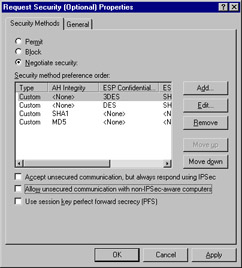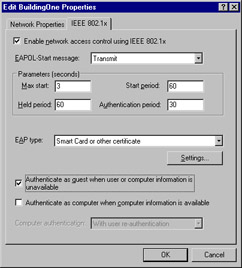Self Test
A Quick Answer Key follows the Self Test questions. For complete questions, answers, and explanations to the Self Test questions in this chapter as well as the other chapters in this book, see the Self Test Appendix.
Securing the Network Infrastructure
| 1. | A recent task force in your company defined several threats to the network that need to be addressed. As the head of that task force, you have been assigned the job of mitigating these threats with the least restriction to users and network availability. The top threat was identified as password attacks. Which solution would best address this threat while still meeting the criteria set forth?
| |
| 2. | Your firm has 12 Windows XP Professional SP1 computers used in a manufacturing environment that are located on the shop floor where about 200 employees work. These computers are used by a variety of staff, and in any given work day, there might be 20 or 30 people that log on to the various computers. Recently, you ve noticed some odd IP traffic on the computers early in the morning, just before the start of the first shift. You had previously applied IPSec policy to the computers in this group via an OU that contains these 12 computers. What else could you do that might protect these computers and the network based on this information?
| |
| 3. | You re checking the configuration of several computers that are connected directly to the Internet. One of the computers recently suffered a denial-of-service (DoS) attack, but the other three were fine. You notice that the computers that were not attacked had IPSec policies applied as shown in Figure 5.22. These settings are not the same as on the computer that was attacked. Which setting(s) are the most likely reason why these computers were not attacked or not successfully attacked ?  Figure 5.22: IPSec Settings
| |
| 4. | Your network consists of three servers running Windows NT 4.0 SP6a, two servers running Windows 2000, and one server configured as a domain controller (DC) running Windows 2000. The client computers are a mix of Windows 95, Windows 98, and Windows XP. You decide to upgrade the network to improve security. You retire two of the computers running Windows NT 4.0 and replace them with two computers on which you will configure Windows Server 2003. You install Windows Server 2003 on the first computer and configure it as a DC and DHCP server. You install Windows Server 2003 on the second computer and configure it as a DC and DNS server. You configure secondary DHCP and DNS server services on one of the Windows 2000 computers, which is configured as a member server. After you complete this, you find that none of the Windows 95 computers can connect to the domain and only some of the Windows 98 computers can. What is the most likely cause of this problem?
| |
Answers
| 1. | B |
| 2. | A |
| 3. | A |
| 4. | C |
Designing Security for Wireless Networks
| 5. | You ve just been hired as the IT manager for a small company. The company s IT infrastructure consists of one domain, three segments, a handful of servers, and about 95 client computers, most of which are running Windows XP. Internet access is provided through a firewall and proxy server via an Internet service provider (ISP). The corporate Web site is hosted externally by a third party, and employees connect to the Web site just as they would to any other Web site. The company has recently expanded and there are two groups of employees who regularly share files among themselves using Windows XP-based laptops. You ve been tasked with finding a solution that will provide these two groups with connectivity in two different areas to enable file sharing. As always, the company is on a tight budget and wants this done quickly on a small budget. What s the best solution?
| |
| 6. | Your firm has three wireless network defined via Wireless Network (IEEE 802.1X) Policies. One network is configured to use Network authentication (Shared mode) . The two other wireless networks use Data encryption (WEP enabled) . Based on this information, what steps can you take immediately to improve security across the board?
| |
| 7. | You are implementing a wireless network in portions of your large warehouse facility. There are a number of computers used by different users throughout the day for pulling or verifying orders. Users log on with smart cards to verify their identity so that orders are tied to user logon for verifying inventory, order accuracy, and other business metrics. You implement PEAP with EAP-TLS for strong authentication since users have smart cards. Throughout the day, some of these computers are used and some are idle and the pattern of usage varies depending on the day, time, and volume of business. You typically manage these computers remotely so that you can do things like update virus definition files or install software upgrades. You configure the settings as shown in Figure 5.23. Based on this information, what is the most likely result?  Figure 5.23: Network Configuration
| |
| 8. | Your network infrastructure already makes use of PKI technologies to create a secure network environment. The infrastructure included a remote access server, and most servers are running Windows Server 2003, although there are still a handful running Windows 2000. All clients have been upgraded over the past 18 months to Windows XP. You recently added IAS to your infrastructure and configured the remote access server as a RADIUS client. You have implemented several wireless networks in your building. You ve installed numerous wireless access points throughout the building and coverage is quite good throughout the building where wireless users roam. There is an area of the building that is not configured with WAPs because the area is a secure area that requires strong authentication just to physically access the area. You have not implemented wireless security in this area but are concerned about rogue WLANs being installed by employees in this highly secure area. What is the best solution to this situation?
| |
Answers
| 5. | A |
| 6. | B |
| 7. | D |
| 8. | A |
EAN: 2147483647
Pages: 122